化学学报 ›› 2019, Vol. 77 ›› Issue (11): 1194-1202.DOI: 10.6023/A19080306 上一篇 下一篇
研究论文
投稿日期:2019-08-19
发布日期:2019-10-22
通讯作者:
夏敏
E-mail:xiamin@zstu.edu.cn
基金资助:
Liu Xiaojing, Jia Yanrong, Jiang Hao, Gao Guanlei, Xia Min*( )
)
Received:2019-08-19
Published:2019-10-22
Contact:
Xia Min
E-mail:xiamin@zstu.edu.cn
文章分享
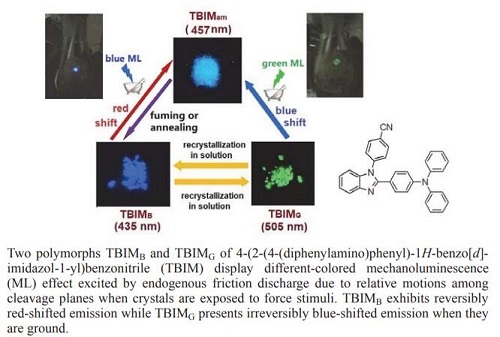
通过芳香亲核取代、还原以及DMSO/空气条件下的氧化成环反应合成了(4-二苯氨基苯基)-1H-苯并咪唑基苯腈(TBIM),化合物的溶液经挥发获得两种晶体TBIMB与TBIMG,前者具有深蓝色荧光(435 nm)而后者则具有绿色荧光(505 nm).受力后两者均成为具有青色荧光(457 nm)的无定形粉末,在溶剂熏蒸或热退火条件下前者的荧光可完全恢复,而后者只能转变为前者的荧光.此外,TBIMB与TBIMG晶体受力后可分别发出蓝色(432 nm)和绿色(500 nm)的闪光.两种晶体都属于中心对称空间群且晶体内分子对的净偶极矩几乎为零,压电效应与破碎晶体表面分子对间的放电激发理论并不适用于解释两种晶体的摩擦发光.分子的链状堆积结构使晶体在受力下很容易发生解理并引起解理面之间的相对运动导致内生摩擦放电,从而激发解理面上的分子使之产生荧光辐射,这种机制很有可能是该两种晶体出现摩擦发光活性的主要原因.
刘笑静, 贾彦荣, 江豪, 高贯雷, 夏敏. 三苯胺取代的苯并咪唑的两种晶体:具有不同颜色的摩擦发光与相反发射位移的力致荧光变色[J]. 化学学报, 2019, 77(11): 1194-1202.
Liu Xiaojing, Jia Yanrong, Jiang Hao, Gao Guanlei, Xia Min. Two Polymorphs of Triphenylamine-substituted Benzo[d]imidazole: Mechanoluminescence with Different Colors and Mechanofluorochromism with Emission Shifts in Opposite Direction[J]. Acta Chimica Sinica, 2019, 77(11): 1194-1202.

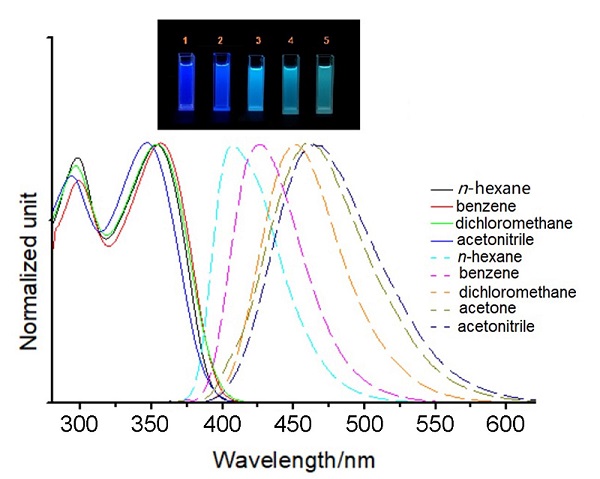
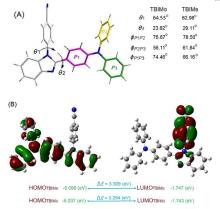

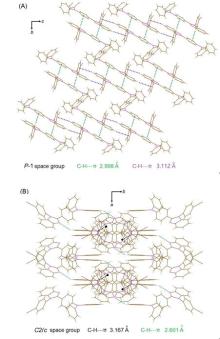

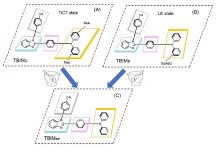

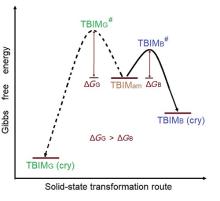


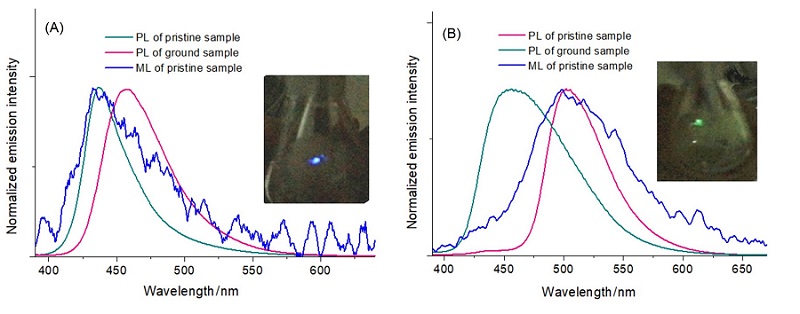
| [1] | (a) Peng, B. Y.; Xu, S. D.; Chi, Z. G.; Zhang, X. Q.; Zhang, Y.; Xu, J. R. Prog. Chem. 2013, 25, 1805 (in Chinese). |
| (彭邦银, 许适当, 池振国, 张锡奇, 张艺, 许家瑞, 化学进展, 2013, 25, 1805.) | |
| (b) Di, B. H.; Chen, Y. L. Chin. Chem. Lett. 2018, 29, 245; | |
| (c) Yuan, Y.; Yuan, W.; Chen, Y. L. Sci. China Mater. 2016, 59, 507; | |
| (d) Yuan, W.; Yuan, Y.; Chen, Y. L. Acta Polym. Sinica 2016, 11, 1495 (in Chinese). | |
| (袁伟, 袁媛, 陈于蓝, 高分子学报, 2016, 11, 1495.) | |
| (e) Yang, J.; Chi, Z.; Zhu, W.; Tang, B. Z.; Li, Z. Sci. China Chem. 2019, 62, 1090; | |
| (f) Li, Q.; Li, Z. Adv. Sci. 2017, 4, 1600484. | |
| [2] | (a) Dong, Y. Q.; Lam, J. W. Y.; Tan, B. Z. J. Phys. Chem. Lett. 2015, 6, 3429; |
| (b) Chi, Z.; Zhang, X.; Xu, B.; Zhou, X.; Ma, C.; Zhang, Y.; Liu, S.; Xu, J. Chem. Soc. Rev. 2012, 41, 3878; | |
| (c) Wang, C.; Li, Z. Mater. Chem. Front. 2017, 1, 2174; | |
| (d) Yang, Z.; Chi, Z.; Mao, Zhang, Z. Y.; Liu, S.; Zhao, J. M.; Aldred, P.; Chi, Z. Mater. Chem. Front. 2018, 2, 861; | |
| (e) Varughese, S. J. Mater. Chem. C 2014, 2, 3499; | |
| (f) Sagara, Y.; Yamane, S.; Mitani, M.; Weder, C.; Kato, T. Adv. Mater. 2016, 28, 1073; | |
| (g) Bian, G. F.; Huang, H.; Zhan, L. L.; Lü, X. J.; Cao, F.; Zhang, C.; Zhang, Y. J. Acta Phys.-Chim. Sin. 2016, 32, 589(in Chinese). | |
| (边高峰, 黄华, 占玲玲, 吕晓静, 曹枫, 张诚, 张玉建, 物理化学学报, 2016, 32, 589.) | |
| (h) Sun, J. B.; Zhang, G. H.; Jia, X. Y.; Xue, P. C.; Jia, J. H.; Lu, R. Acta Chim. Sinica 2016, 74, 165(in Chinese). | |
| (孙静波, 张恭贺, 贾小宇, 薛鹏冲, 贾俊辉, 卢然, 化学学报, 2016, 74, 165); | |
| (i) Ouyang, M.; Yu, C. H.; Zhang, Y. J.; Hu, B.; Lü, X. J.; Sun, J. W.; Zhang, C. Acta Phys.-Chim. Sin. 2012, 28, 2944(in Chinese). | |
| (欧阳密, 俞春辉, 张玉建, 胡彬, 吕晓静, 孙璟玮, 张诚, 物理化学学报, 2012, 28, 2944.) | |
| [3] | (a) Seki, T.; Takamatsu, Y.; Ito, H. J. Am. Chem. Soc. 2016, 138, 6252; |
| (b) Jin, M.; Seki, T.; Ito, H. J. Am. Chem. Soc. 2017, 139, 7452; | |
| (c) Yagai, S.; Okamura, S.; Nakano, Y.; Yamauchi, M.; Kishikawa, K.; Karatsu, T.; Kitamura, A.; Ueno, A.; Kuzuhara, D.; Yamada, H.; Seki, T.; Ito, H. Nat. Commun. 2014, 5, 4013. | |
| [4] | (a) Zheng, K.; Zheng, Y.; Peng, L.; Xiang, Y.; Tong, A. J. J. Phys. Chem. C 2017, 121, 21610; |
| (b) Lü, Y.; Liu, Y.; Ye, X.; Liu, G. F.; Tao, X. T. CrystEngComm 2015, 17, 526; | |
| (c) Chung, K.; Kwon, M. S.; Leung, B. M.; Kim, J. S. ACS Cent. Sci. 2015, 1, 94. | |
| [5] | (a) Shi, P.; Duan, Y.; Wei, W.; Xu, Z.; Li, Z.; Han, T. J. Mater. Chem. C 2018, 6, 2476; |
| (b) Feng, C.; Wang, K.; Xu, Y.; Liu, L.; Zou, B.; Lu, P. Chem. Commun. 2016, 52, 3836; | |
| (c) Wang, L.; Wang, K.; Zou, B.; Ye, K.; Zhang, H.; Wang, Y. Adv. Mater. 2015, 27, 2918; | |
| (d) Xie, W.-Z.; Zheng, H.-C.; Zheng, Y.-S. J. Mater. Chem. C 2017, 5, 10462. | |
| [6] | (a) Hirata, S.; Watanabe, T. Adv. Mater. 2006, 18, 2725; |
| (b) Lim, S. J.; An, B. K.; Jung, S. D.; Chung, M. A.; Park, S. Y. Angew. Chem., Int. Ed. 2004, 43, 6346; | |
| (c) Olson, C. E.; Previte, M. J. R.; Fourkas, J. T. Nat. Mater. 2002, 1, 225; | |
| (d) Irie, M.; Fukaminato, T.; Sasaki, T.; Tamai, N.; Kawai, T. Nature 2002, 420, 759. | |
| [7] | (a) Kishimura, A.; Yamashita, T.; Yamaguchi, K.; Aida, T. Nat. Mater. 2005, 4, 546; |
| (b) Zhu, X.; Liu, R.; Li, Y.; Huang, H.; Wang, Q.; Wang, D.; Zhu, X.; Liu, S.; Zhu, H. Chem. Commun. 2014, 50, 12951; | |
| (c) Qi, Q.; Liu, Y.; Fang, X.; Zhang, Y.; Chen, P.; Wang, Y.; Yang, B.; Xu, B.; Tian, W.; Zhang, S. X. RSC Adv. 2013, 3, 7996; | |
| (d) Kumar, P.; Dwivedi, J.; Gupta, B. K. J. Mater. Chem. C 2014, 2, 10468; | |
| (e) Lu, X.-L.; Xia, M. J. Mater. Chem. C 2016, 4, 9350. | |
| [8] | (a) Yuan, W. Z.; Tan, Y.; Gong, Y.; Lu, P.; Lam, J. W. Y.; Shen, X. Y.; Feng, C.; Sung, H. Y.; Lu, Y.; Williams, I. D.; Sun, J. Z.; Zhang, Y.; Tang, B. Z. Adv. Mater. 2013, 25, 2837; |
| (b) Li, C.; Tang, X.; Zhang, L.; Li, C.; Liu, Z.; Bo, Z.; Dong, Y. Q.; Tian, Y.-H.; Dong, Y.; Tang, B. Z. Adv. Optical Mater. 2015, 3, 1184; | |
| (c) Naeem, K. C.; Subhakumari, A.; Varughese, S.; Nair, V. C. J. Mater. Chem. C 2015, 3, 10225; | |
| (d) Sun, J.; Han, J.; Liu, Y.; Duan, Y.; Han, T.; Yuan, J. J. Mater. Chem. C 2016, 4, 8276; | |
| (e) Xue, P.; Yang, Z.; Chen, P. J. Mater. Chem. C 2018, 6, 4994. | |
| [9] | (a) Sagara, Y.; Kato, T. Angew. Chem. Int. Ed. 2011, 50, 9128; |
| (b) Yoon, S.-J.; Chung, J. W.; Gierschner, J.; Kim, K. S.; Choi, M.-G.; Kim, D.; Park, S. Y. J. Am. Chem. Soc. 2010, 132, 13675; | |
| (c) Sun, H.; Liu, S.; Lin, W.; Zhang, K. Y.; Lü, W.; Huang, W.; Huo, F.; Yang, H.; Jenkins, G.; Zhao, Q.; Huang, W. Nat. Commun. 2014, 5, 3601; | |
| (d) Zhang, K. Y.; Liu, S.; Zhao, Q.; Huang, W. Coord. Chem. Rev. 2016, 319, 180; | |
| (e) Chen, X.; Sun, G.; Zhang, T.; Liu, S.; Zhao, Q.; Huang, W. Adv. Mater. 2016, 28, 7137; | |
| (f) Zhao, Q.; Xu, W.; Sun, H.; Yang, J.; Zhang, K. Y.; Liu, S.; Ma, Y.; Huang, W. Adv. Opt. Mater. 2016, 4, 1167; | |
| (g) Lin, W.; Zhao, Q.; Sun, H.; Zhang, K. Y.; Yang, H.; Yu, Q.; Zhou, X.; Guo, S.; Liu, S.; Huang, W. Adv. Opt. Mater. 2015, 3, 368; | |
| (h) Han, J.; Sun, J.; Li, Y.; Duan, Y.; Han, T. J. Mater. Chem. C 2016, 4, 9287. | |
| [10] |
(a) Xu, B.; Li, W.; He, J.; Wu, S.; Zhu, Q.; Yang, Z.; Wu, Y.-C.; Zhang, Y.; Jin, C.; Lu, P.-Y.; Chi, Z.; Liu, S.; Xu, J.; Bryce, M. R. Chem. Sci. 2016, 7, 5307;
doi: 10.6023/A17110504 |
|
(b) Xu, S.; Liu, T.; Mu, Y.; Wang, Y.-F.; Chi, Z.; Lo, C.-C.; Liu, S.; Zhang, Y.; Lien, A.; Xu, J. Angew. Chem. 2015, 127, 888;
doi: 10.6023/A17110504 |
|
|
(c) Yang, J.; Ren, Z.; Xie, Z.; Liu, Y.; Wang, C.; Xie, Y.; Peng, Q.; Xu, B.; Tian, W.; Zhang, F.; Chi, Z.; Li, Q.; Li, Z. Angew. Chem. Int. Ed. 2017, 56, 880;
doi: 10.6023/A17110504 |
|
|
(d) Neen, K. K.; Sudhakar, P.; Dipak, K.; Thilagar, P. Chem. Commun. 2017, 53, 3641;
doi: 10.6023/A17110504 |
|
|
(e) Xu, B.; He, J.; Mu, Y.; Zhu, Q.; Wu, S.; Wang, Y.; Zhang, Y.; Jin, C.; Lo, C.; Chi, Z.; Lien, A.; Liu, S.; Xu, J. Chem. Sci. 2015, 6, 3236;
doi: 10.6023/A17110504 |
|
|
(f) Nakayama, H.; Nishida, J.; Takada, N.; Sato, H.; Yamashita, Y. Chem. Mater. 2012, 24, 671;
doi: 10.6023/A17110504 |
|
|
(g) Nishida, J.; Ohura, H.; Kita, Y.; Hasegawa, H.; Kawase, T.; Takada, N.; Sato, H.; Sei, Y.; Yamashita, Y. J. Org. Chem. 2016, 81, 433;
doi: 10.6023/A17110504 |
|
|
(h) Liu, M. L.; Wu, Q.; Shi, H. F.; An, Z. F.; Huang, W. Acta Chim. Sinica 2018, 76, 246(in Chinese). (刘明丽, 吴琪, 史慧芳, 安众福, 黄维, 化学学报, 2018, 76, 246.)
doi: 10.6023/A17110504 |
|
| [11] | (a) Wang, C.; Xu, B.; Li, M.; Chi, Z.; Xie, Y.; Li, Q.; Li, Z. Mater. Horiz. 2016, 3, 220; |
| (b) Liu, F.; Tu, J.; Wang, X.; Wang, J.; Gong, Y.; Han, M.; Dang, X.; Liao, Q.; Peng, Q.; Li, Q.; Li, Z. Chem. Commun. 2018, 54, 5598. | |
| [12] | (a) Yang, J.; Ren, Z.; Chen, B.; Fang, M.; Zhao, Z.; Tang, B. Z.; Peng, Q.; Li, Z. J. Mater. Chem. C 2017, 5, 9242; |
| (b) Yang, J.; Ren, Z.; Xie, Z.; Liu, Y.; Wang, C.; Xie, Y.; Peng, Q.; Xu, B.; Tian, W.; Zhang, F.; Chi, Z.; Li, Q.; Li, Z. Angew. Chem. Int. Ed. 2017, 56, 880. | |
| [13] |
Xie Z.; Yu T.; Chen J.; Ubba E.; Wang L.; Mao Z.; Su T.; Zhang Y.; Aldred M. P.; Chi Z. Chem. Sci. 2018, 9, 5787
doi: 10.1039/C8SC01703D |
| [14] |
Hardy G. E.; Baldwin J. C.; Zink J. I.; Kaska W. C.; Liu P.; Dubois L. J. Am. Chem. Soc. 1977, 99, 3552
doi: 10.1021/ja00453a002 |
| [15] |
Zink J. I.; Chandra B. P. J. Phys. Chem. 1982, 86, 5
doi: 10.1021/j100390a003 |
| [1] | 贾彦荣, 徐凯, 赵彦英, 倪华钢, 吴滢, 夏敏. 推拉电子基团区域异构苯并咪唑的发射行为与力致荧光变色性能研究[J]. 化学学报, 2023, 81(12): 1716-1723. |
| [2] | 易君明, 肖欣, 张云黔, 薛赛凤, 陶朱, 张建新. 八元瓜环与1,7-二(2-苯并咪唑)-庚烷的超分子自组装[J]. 化学学报, 2014, 72(8): 949-955. |
| [3] | 卢艳梅, 区志镔, 胡伟, 乐学义. (2-(2'-吡啶)苯并咪唑)(L-丙氨酸根)铜(II)配合物结构、抗菌活性及DNA断裂作用[J]. 化学学报, 2012, 70(08): 973-979. |
| [4] | 易平贵, 周继明, 于贤勇, 汪朝旭, 李筱芳, 刘峥军, 侯博. 2-(2′-氨基苯基)苯并咪唑衍生物分子内质子转移理论研究: 取代基效应[J]. 化学学报, 2012, 70(06): 699-706. |
| [5] | 岳可芬, 卓飞, 侯磊, 姜严梅, 翟高红, 尹兵, 王尧宇, 文振翼. 1,3-二(1-二茂铁磺酰基-2-苯并咪唑)丙烷的合成、单晶结构和量子化学研究[J]. 化学学报, 2011, 69(05): 596-600. |
| [6] | 谢湖均, 雷群芳, 胡晓环, 宣贵达, 方文军. 1-取代-2-氨基苯并咪唑衍生物的理论计算及QSAR研究[J]. 化学学报, 2011, 69(04): 399-404. |
| [7] | 陈战国, 王传宁, 赵朋飞, 王芸, 周利燕. 2-甲基苯并咪唑基异黄酮衍生物的合成及抗氧化活性[J]. 化学学报, 2010, 68(22): 2347-2355. |
| [8] | 岳可芬, 姜严梅, 宋扬, 姜富灵, 黄小英, 李涛, 王诚军, 王尧宇. 一个“囍”字配合物的合成、晶体结构、量化计算及抑菌活性[J]. 化学学报, 2010, 68(13): 1291-1297. |
| [9] | . 由二茂铁基羧酸以及苯并咪唑基配体构筑的两个镉(II)配合物的合成、晶体结构及性质[J]. 化学学报, 2009, 67(9): 1026-1031. |
| [10] | 易平贵, 王涛, 周继明, 彭洪亮, 李筱芳, 于贤勇, 汪朝旭. 2-(3-羟基-2-吡啶基)-苯并咪唑的合成、晶体结构及光谱研究[J]. 化学学报, 2009, 67(24): 2803-2808. |
| [11] | 朱莉,于贤勇,龙云飞,林原斌. 2-苯并咪唑吡啶镍配合物的合成﹑晶体结构及与DNA相互作用的共振散射光谱研究[J]. 化学学报, 2009, 67(2): 139-144. |
| [12] | 李庆祥,沈云军,孟祥高. 1-亚甲基苯并咪唑-1,4,7-三氮环壬烷配体及其铜配合物[Cu(C14H21N5)Br]2•[CuBr4]的合成与晶体结构[J]. 化学学报, 2008, 66(2): 266-270. |
| [13] | 冯少波a 张 业b 周 琪a 李芳耀c 潘英明a 陈振锋a 王恒山,a. 新型脱氢松香基苯并咪唑类衍生物的合成及其氯离子识别性能[J]. 化学学报, 2008, 66(12): 1490-1496. |
| [14] | 闫振忠, 唐瑜, 谭民裕, 刘伟生, 王大奇. 2,6-二(2-苯并咪唑基)吡啶与稀土苦味酸盐配合物的合成、晶体结构及荧光性质研究[J]. 化学学报, 2007, 65(7): 607-614. |
| [15] | 国永敏, 李宝宗. 2-巯基苯并咪唑及其类似物互变异构的理论研究[J]. 化学学报, 2007, 65(16): 1561-1567. |
| 阅读次数 | ||||||
|
全文 |
|
|||||
|
摘要 |
|
|||||